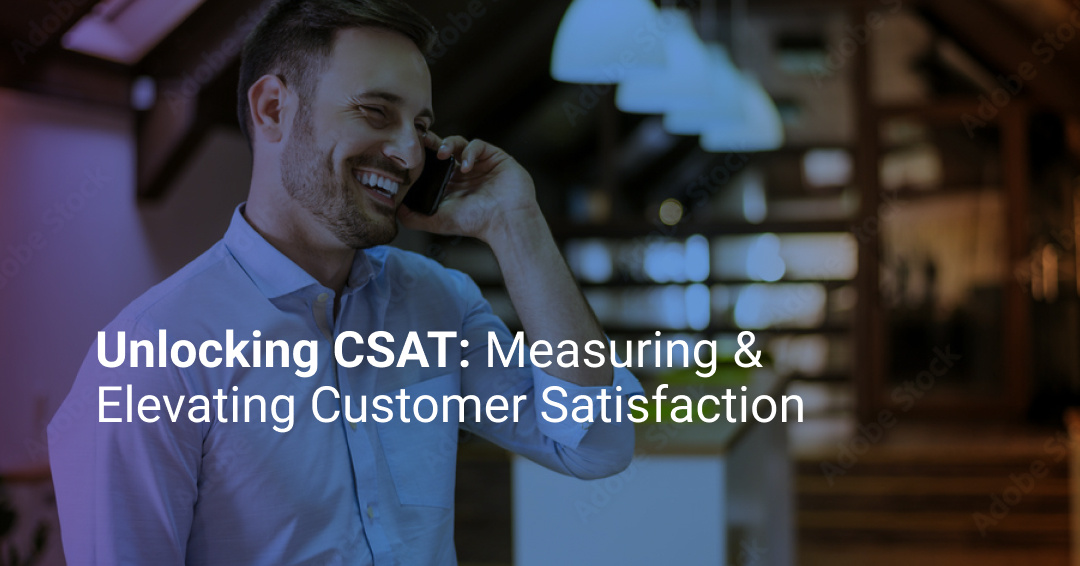12 Call Center Metrics You Should Be Using to Improve CX in 2025
Call center metrics are the most important performance indicators that monitor how effectively your call center is running. This includes anything...

Personalized customer experiences have become a necessity. Customers expect businesses to not only offer excellent products and services but also to guide them towards the best choice for their unique needs. This requires a business to understand its audience, which is where customer journey orchestration comes into play.
By observing the customer journey over time, and their actions and preferences at every touchpoint, businesses gain an opportunity to craft tailored campaigns with a higher chance of conversion.
The global customer journey market is projected to cross $46 billion by 2030, an increase of nearly 19 percent from 2020. Mapping customer journeys and orchestrating that data into leads has already seen businesses reap over 20 percent revenue gains.
Here is everything you need to know about building and orchestrating your business' customer journey to improve customer experience.
Having been a critical part of digital marketing for years, customer journey orchestration is a strategy that uses real-time insights such as behaviors and actions to optimize (and improve) customer experience. The approach personalizes each customer's journey as it occurs, allowing businesses to better connect with their customers.
For example, the data might show how a customer favors a promotional email in the evening instead of the morning or prefers engagement via social media platforms instead of SMS messages. Such valuable insights can be used to create tailored marketing campaigns with a high chance of improving customer engagement, boosting their experience, and increasing the brand’s value.
It is also equally important to understand how the concept of customer journey orchestration shares similarities with customer journey mapping. The difference lies in their execution. Journey mapping is the first step. It creates a visual representation of how customers interact with your brand, what paths they took to get to a particular point, their pre-purchase and post-purchase awareness and experiences, etc. Journey orchestration, on the other hand, manages the mapped data to find ways to optimize the customers’ pathing.
Imagine a marketing campaign to sell tickets for an upcoming event. While customers may interact with the campaign ads, there is no guarantee they will purchase a ticket on their first interaction. On the other hand, customers who buy a ticket may not have a reason to return to the campaign page. The marketing company will want a way to remind their customers of the ticket sales or keep them re-engaged without spamming them across every channel, which would only reduce their customer experience.
In such a scenario, the company's customer journey orchestration can follow each customer interaction to identify the highest chance of making a sale. The algorithm may determine that most customers are buying tickets via social media ads rather than email newsletters, or that customers regularly visiting the website have a higher chance of interacting with the event ads on the weekends. Such data shows the best way and the best time to engage with customers for sale conversions. Even when the event has expired, customer journey orchestration can still be used to map insights to re-engage with customers.
In another use case where a brand wants to increase its newsletter subscriptions, its customer journey orchestration might identify how customers only sign up for newsletters to receive discounts on particular products. The insights can provide valuable data such as what type of products yields the most subscriptions, the percentage of customers who unsubscribe after making a purchase, customers who initially sign up but do not redeem the discount, etc. Knowing their customers in this case helps the brand initiate targeted and optimized marketing campaigns the next time around.
Finally, an example to showcase customer empathy for loyalty gains. Customers with unresolved issues are unlikely to appreciate your marketing promotions. With real-time monitoring and cross-channel data sharing, journey orchestration tools can deliver more appropriate messages such as a reminder that the customer’s issue is being investigated or a survey feedback.
The role of customer journey orchestration has become an important cornerstone for every business marketing strategy, especially with digital commerce on the rise.
Not every customer uses the same device or platform to interact with your business. Some may prefer a particular channel or even multiple channels for that matter. Identifying your customers' preferences is one of the first steps to offering them personalized experiences.
Remember that in today's digital marketplace, customers are continually receiving (or seeing) numerous marketing messages every day. The only way for a business to stand out is to deliver tailored experiences.
Using customer journey orchestration to obtain real-time data allows a brand to fulfill every customer's requirements at every point in their journey. This also ensures consistent customer experience across all channels to improve customer relationship metrics, which include loyalty for retention and long-term business relations.
Increasing customer engagement means delivering contextual experiences at every step in their journey. This requires real-time data from every possible department or source that can share customer information.
For example, mapping customer profiles by recognizing their in-store/online interactions and habits, noting customer support queries, identifying preferred channels and trends, and more. Such real-time data helps create real-time responses and clear communications, as well as eliminate steps that could potentially create roadblocks or reduce customer loyalty.
Another benefit of customer journey orchestration is how a platform can be fully automated with minimal human input. Machine learning and AI algorithms ensure real-time mapping and management of every customer touchpoint around the clock before handing over the complete journey. This also includes automated post-sales follow-ups such as making recommendations or setting reminders for a particular service.
The ultimate goal is always to deliver personalized customer experiences, which would not be possible without first seeing the big-picture view of the customer's journey. This is how a business converts its data-backed marketing campaigns into a one-on-one conversation with the customer.
It is normal for customers to become frustrated if they have to contact customer service multiple times to resolve issues, especially if customer support fails to identify their problem. With customer journey orchestration tools, businesses can close that customer service gap. When critical data and contextual information can be gathered from the first interaction, the support team becomes better equipped to address problems on the first call.
Every business and its customer base is unique. The same customer will not interact with one brand the same way as they do with another. Hence, improving customer engagement means understanding interactions between a business and its customers. From the first touchpoint to purchase and beyond, your journey orchestration strategies must be aligned with your customer’s needs. Here is how to orchestrate an excellent customer experience.
Data comes in many shapes and forms. Ensuring a consistent customer experience across all channels requires you to first understand what types of data sets can be collected from every possible source. These can vary from business to business, as well as customer to customer, but commonly include the following in today's digital world.
Most customers use multiple channels during their purchase journey. Hence, your next step in improving their journey should be to focus on providing seamless customer experiences across multiple channels. Your journey orchestration tools will identify how, where, and when to engage with customers as part of a multi-faceted approach.
That said, each channel should feature a tailored experience. Whether a customer makes a purchase from your app or website, mobile or laptop, each channel should reflect the experience while giving the same quality and service.
The final step in elevating customer experience is to manage your real-time data, which can often be a daunting amount of information. The right journey orchestration tools will make it easier to analyze those insights. The best analysis will not only outline campaigns on an individual level but also predict future intents. Hence, your orchestration data should be used to optimize a customer journey towards a sale while also identifying prospects to re-engage in the future. For example, what actions have historically led to a purchase, what content types saw the longest sessions, what channels proved to be favorable, etc.
Customer journey orchestration is a real-time and personalized approach to interacting with customers. This approach leverages real-time customer data from multiple touchpoints to determine how best to interact with a customer. Businesses can leverage data from past and present interactions to engage with each customer in a personalized way and build relationships. In this way, customer journey orchestration improves customer experience outcomes by providing customers with interactions that meet their individual needs.
Business leaders may already be familiar with a similar term: customer journey management. While the name seems the same, customer journey management is less individualized. It takes a comprehensive look at segmented customer behaviors to gauge insights. Customer journey management groups customers according to specific characteristics, such as demographics or behavior metrics. This approach does not include all the touch points that customer journey orchestration does.
Customer journey orchestration goes further. It is more customer-centric and maps strategy based on an individual customer’s behavior. Customer journey orchestration’s role in a customer engagement strategy is to anticipate and improve personal journeys with a company. This includes the journey to the purchase decision and interactions after.
Your orchestration engine requires data as fuel, and that data comes as part of the mapping process. Hence, a customer journey orchestration is only as effective as its customer journey map. AI technology, machine learning, and automation ensure an accurate journey map that visualizes all the steps a customer takes through their journey or experience with a brand.
From the first interaction with a business to tracking an order, journey maps provide information on how a customer cultivates a relationship with a brand. This is vital for any business looking to optimize its customer experience.
Do note that an orchestration platform can yield several customer journey maps across different channels, behaviors, actions, audiences, and other metrics. However, not all of them will be useful and most must be fine-tuned before they can be used to create campaigns. This is where customer journey orchestration comes in. It streamlines the journey by taking the most contextual information from the mapping phase before working to improve each touchpoint.
The following are the typical steps in a customer journey, visualized in a customer journey map.
As the image illustrates, journey maps visually depict a customer’s touchpoints across the organization. This visual depiction of customer touchpoints helps businesses improve customer journey orchestration. Decision makers can see touchpoints they might have overlooked, such as reviews, social media, or surveys, and gather relevant customer data to improve the customer experience.
One significant benefit of customer journey mapping is the opportunity to bring a refreshed customer perspective to strategic planning. For example, businesses can review customer purchase habits to inform decisions companywide, from marketing to product design to customer support.
A customer journey map reinforces the importance of constant customer input, reminding employees that they create experiences for the customer. Employees can shift their perspective from profit-focused to customer-focused.
Another benefit is increased customer retention. When customers are happy, they don’t leave. Companies that make the customer experience a more efficient interaction increase customer satisfaction and lower churn.
Knowledge of the steps on a customer journey map and investment in tools to enhance those steps improve customer journey orchestration and customer experience.
Customer journey technology refers to the tools and software that help organizations enhance and improve the customer journey. Below are two beneficial customer journey tools business leaders can utilize to enhance the overall customer experience.
Customer insight programs can provide unbiased and objective data based on a customer’s movements. Insight can include purchase habits, time spent on a brand’s website, demographic information, and advertising and social media analytics.
Customer insight programs provide real-time insights to help inform customer journey orchestration. Business leaders can visualize the entire journey and identify areas of improvement across interactions. These insights can also help improve customer care processes such as automation, collections, and sales.
AI technology, such as IVAs, can streamline and personalize the customer experience. Mosaicx provides business leaders with AI-driven IVAs that help customers interact with a brand with ease. IVAs use natural language understanding (NLU) or natural language processing (NLP) to generate personalized responses to users.
IVAs can interact with customers through multiple customer journey touchpoints. For example, IVAs can answer customer questions about products or services, help customers make purchases, and check order statuses.
IVAs can also offer surveys after a customer makes a purchase or signs up for a loyalty program. A customer satisfaction survey provides decision-makers with honest and individual information about the customer experience. With this information, companies can improve their customer engagement strategies.
Customer journey orchestration creates customer-centric organizations through real-time, personalized customer experiences. Business leaders who want to uplevel customer relationships with real-time insights can consider implementing customer journey technology.
Through customer journey orchestration, business leaders prioritize the customer experience and, as a result, increase brand loyalty and satisfaction.
The term "journey orchestration engine" refers to a platform especially built and engineered to map customer journeys. It utilizes various orchestration tools and features to gather data, provide customer analytics, and help devise omnichannel campaigns.
Every digital business or brand can reap great benefits from a journey orchestration engine to build and execute personalized campaigns from one place instead of managing them individually. The amount of collected data from various channels would otherwise make the process too overwhelming and cumbersome.
While you can find a range of orchestration platforms on the market, Mosaicx particularly leverages AI-powered tools and machine-learning capabilities to create powerful customer data sets with thorough customer analytics. It offers complete control over every aspect of a customer's journey across all channels and devices.
Ready to map and optimize your customers' journeys across all channels? Contact us to try Mosaicx for yourself and start creating personalized customer experiences for your brand.

Call center metrics are the most important performance indicators that monitor how effectively your call center is running. This includes anything...

Businesses across industries have changed or evolved over the decades, but one thing that has remained the same is that their growth is pretty much...

Customers have several major expectations from modern businesses, but none is as challenging as them reading your mind to anticipate support you...